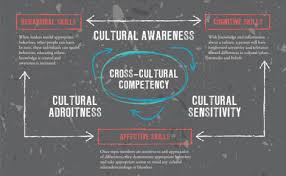
Diversity and Cross-Cultural Training
Order Instructions:
THIS IS A TWO-PART ASSIGNMENT. PLEASE TYPE ALL ANSWERS UNDER THE QUESTIONS.
ASSIGNMENT INSTRUCTIONS FROM THE INSTRUCTOR:
Use your Blanchard and Thacker text, Effective Training, to complete the following:
Analyzes course concepts, theories, or materials correctly, using examples or supporting evidence.
Analyzes course concepts, theories, or materials correctly, using examples or supporting evidence.
References:
Blanchard, N. P., & Thacker, J. (2013). Effective training (5th ed.). Upper Saddle River, NJ: Prentice Hall
ASSIGNMENT:
PART 1: Diversity and Cross-Cultural Training
Working with coworkers who are from a different background, culture, or race from our own can be a challenge. Training people in how to function in a multicultural environment is critical to organizational success today. It can be very challenging for a training professional to develop and implement cross-cultural training. This is definitely one place for active involvement in the training program, and is critical to the program’s success.
1. Briefly describe a diversity or cross-cultural program that you have attended that was successful.
2. Why do you think this program was a success?
PART 2: Employee Orientation Programs
You have most likely been part of a formal or informal new employee orientation program. Some of these experiences may have been positive and effective, while others may have been less than effective.
1. Briefly describe a new employee orientation you have experienced.
2. Provide two specific reasons why you feel the program was effective or ineffective.
3.What changes (if any) would you recommend to improve the program and your experience?
SAMPLE ANSWER
Employment and development training
Part 1
Diversity refers to the differences that occur in human beings that are found in a particular institution, firm, organization or society. The difference comes in many forms that include race, religion, ethnic background, language among other things (Adra et al., 2011). These aspects that differentiate one individual from another are very common in the whole world. Therefore, the global approaches of managing these aspects that differentiate one individual from the other assist us in working towards a common goal (Adra et al., 2011). The common goal focuses on a particular setting as in an organization, where the goal may be to achieve the strategic business objectives of the organization.
However, this paper will focus on the various activities aimed at managing these cross-cultural differences among employees of the same organization. The efficient management of diversity has a lasting positive effect on the productivity of every employee as well as that of the whole organization. I happened to get a chance to attend a seminar on the understanding and dealing with diversity in an organization. The seminar ran for one week. During the one week, many activities ensued. The theme of the seminar was,” using diversity to attain a successfully diversified working environment”. According to me, all the activities that I took part in aimed at working towards realizing the objectives of the theme.
The program can be classified to be a training or development program. Almost all the activities’ goal was to develop and train employees’ organizational behavior that would tolerate and embrace the diversified nature of organizations. The training helped in illustrating that discrimination would only work towards hindering the progress of the company. Therefore, the earlier individuals embrace diversity and use it for a better purpose, the better it will be for everybody in the organization.
The program was a complete success. The reason being that employee interaction increased by a significant amount. I personally witnessed that. Therefore, the communication process in the organization became more efficient.
Part 2
However, some orientation programs aimed at successfully integrating an employee into an organization are quite useful. One such program I encountered during the seminar is the get to know each other program. The program entailed different activities that gave a new employee a clear picture of the structure of leadership in the organization. Moreover, it provided the employee with a distinct perspective on what channels of communication one should use for each situation encountered. Furthermore, it gave me an opportunity to get to know other employees, supervisors, HR and managers in the organization. Also, to get to know who to talk to in every situation that I deem sees fit to ask for guidance.
The program has its effective side. The effectiveness comes from the point of employee interaction. Once proper interactions are made, it is easier for me, the employee to approach that person privately to discuss different matters that affect the organization. I may even go for clarification or confirmation of an unclear aspect of the organization without a fuss. Alternately, every good thing has its bad side. The bad side of the program is what I considered the first impression made by the very introductions that make the program effective. It is quite common for employees to dislike each other for no particular reason, it is considered human nature.
However, if the dislike is not overcome or dealt with accordingly, the relationship between these two individual is headed for a plummet. Therefore, the first impression made by one employee to another can either work for or work against the common goals of the whole organization.
Alternately, there are some things I know that can be done to alter the negative effect of the program on the employees. One of the most important things to reminding employees from time to time is professionalism. When the employees get to see the situation from a professional perspective. Then interpersonal conflicts will not get in the way of professionalism and working together for the benefit of the organization and themselves.
In summary, it is prudent to develop and train the minds of employees to be able to embrace positively the diversity that occurs in a different situation for the benefit of the common good. The activities carried out to ensure that the above statement is accomplished should be conducted in a professional manner. The better the interpersonal skills held by employees, the better the interaction between employees that is significant to the cause of the organization.
References
Adra, S. F., & Fleming, P. J. (2011). Diversity management in evolutionary many-objective optimization. Evolutionary Computation, IEEE Transactions on, 15(2), 183-195.
Greene, A. M., &Kirton, G. (2016). The Dynamics of Managing Diversity: A Critical Approach.
We can write this or a similar paper for you! Simply fill the order form!












